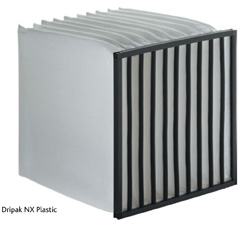Identifying consistent air quality, improved performance, reduction in energy consumption and environmental benefits as the prerequisites of air filtration systems, Prasad Natraj predicts that they will govern the future of the air filtration industry in the region.
Identifying consistent air quality, improved performance, reduction in energy consumption and environmental benefits as the prerequisites of air filtration systems, Prasad Natraj predicts that they will govern the future of the air filtration industry in the region.
 Recent trends in the manufacture and optimising of air filtration systems lie in four clear objectives: consistent air quality, improved performance of the installed air filtration system, reduction in energy consumption and environmental benefits.
Recent trends in the manufacture and optimising of air filtration systems lie in four clear objectives: consistent air quality, improved performance of the installed air filtration system, reduction in energy consumption and environmental benefits.
Air filtration is no longer a necessity only for equipment protection but also for the health and well-being of building occupants. Most people perceive the need for air filters only as a means to protect the cooling/heating coils and equipment downstream, which is patently untrue. Air quality is a key factor in the comfort and health of the building occupant, optimising production processes and reducing the environmental impact.
The importance of clean air
Clean air is something practically impossible to identify by our human senses. Most airborne particulates are so small that they cannot be perceived with the naked eye. In most cases, we do not know when something is wrong with the air quality until it is too late, and when irrecoverable damage has already occurred.
A carefully selected and reliable functioning air filtration system directly determines how effectively harmful contaminants and particulate matter are prevented from entering the air stream, and thus represents a vital link in the overall improvement of Indoor Air Quality (IAQ).
Recent trends in the manufacture and optimising of air filtration systems lie in four clear objectives: consistent air quality, improved performance of the installed air filtration system, reduction in energy consumption and environmental benefits. These objectives govern the future of the air filtration industry in the region.
New guidelines-better IAQ and lower energy use
The new guidelines EN779:2012 & Eurovent Energy Efficiency Classification places high demands on the performance and energy consumption of air filters. The European committee for standardisation (CEN) has established a new standard for testing and classifying coarse and fine filters based on filtration performance and a minimum efficiency requirement.
While on an average, fans in the Air Handling Units utilise 40% of the total energy requirements of a building, the air filters used in those systems consume 25% of their energy demand. No less than 80% of the total costs within the lifecycle of an air filter are energy costs. Low-energy filters, therefore, immediately reduce environmental impact and lower the total cost of ownership. Further, in today’s scenario, reducing energy demand of buildings is not only smart because of governmental regulations but also due to rising energy costs.
With the new guidelines, energy labelling on each category of air filters is already in operation in European countries. The 2014 energy labels on the air filters vary from “E” for low energy efficiency up to and including “A” for extremely high energy efficiency. With this method, Eurovent can validate the claims of manufacturers concerning annual energy consumption of filters. This gives customers a guarantee that the product delivers as per the energy classification.
Green initiatives
Today’s building owners and operators are moving towards sustainable designs and operating practices of increasing efficiency of buildings. The benefits of such sustainable or green buildings include the value-added perception of social responsibility, enhanced IAQ and lower operating costs.
An increasing number of commercial buildings are seeking LEED certification. Proper air filtration strategies can earn LEED credits via Energy and Atmospheric Efficiency, Indoor Environmental Quality, Materials and Resources and Innovation in Design/operations. The higher the efficiency of a filter, the better the IAQ. Filters with lower pressure drop and higher efficiency will lower the operation cost of HVAC systems, resulting in energy savings, which ensure lower energy costs and reduced greenhouse gas emissions.
Lastly, but equally significantly, the potential environmental impact of raw materials used to make filters, and the impact on the environment during the disposing of the filters at the end of service needs to be considered.
IAQ – the Middle East situation
Unfortunately, there appears to be minimal consideration among buyers locally in terms of installing higher efficiency filters which contribute to lower energy consumption, improve IAQ and support green initiatives. The buying patterns are predominantly based on washable-type air filters, which tend to lose arrestance values over repeated washes and increase pressure drops across the media.
Without local certification and a clear directive in place, customers end up paying higher energy costs in operating their HVAC systems and, most significantly, sacrifice on achieving proper IAQ for the building occupants.
With the local presence of recognised global air filter manufacturers these days, and with the ongoing market awareness, the healthcare industry is typically complying with the use of higher efficiency air filters for operation theatre rooms and areas serving critical care. The healthcare industry is very keen to support quality-driven air filter products and the use of sustainable technologies to conserve energy.
The writer is General Manager, Particulate and Molecular Business – Middle East, AAF International Air Filtration Systems LLC. He can be contacted at: pnatraj@aafae. com
Copyright © 2006-2025 - CPI Industry. All rights reserved.